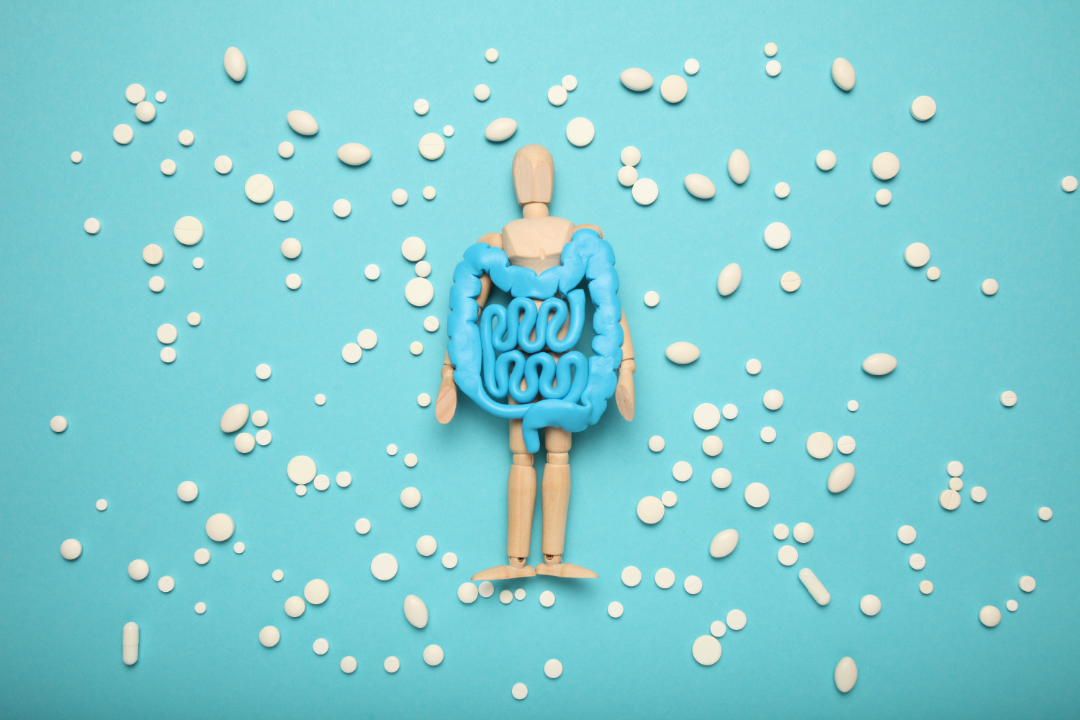
Could the secret to healthy ageing be in your gut?
Thanks to advancements in medical technologies, we get to enjoy longer lifespans than any other period in human history. However, as we age we are also succumbing to higher levels of chronic diseases, such as cancers, inflammatory bowel disease, heart disease, type 2 diabetes, and neurodegenerative diseases1.
There is a common thread that ties these age-related diseases together, and that is the increase of chronic, low-grade inflammation2.
But what if we could reduce the amount of inflammation in our body as we age? Over the past decade, research has identified that the community of microorganisms in our gut, known as the gut microbiome, can play a role in suppressing or promoting inflammation in the body – depending on its composition3.
Age influences your gut microbiome
From birth
As we age, our gut microbiome changes with us. When we are born, we do not have many different types of bacteria in our gut, but as we are introduced to solid foods and exposed to different environments, the amount and types of bacteria in our gut increases4.
Childhood
As we grow up, we start to get more bacteria that are good at breaking down different types of plant fibres and can produce beneficial substances called short chain fatty acids. These short chain fatty acids keep our gut healthy by suppressing inflammation, maintaining our intestinal cell barrier, regulating our appetite and even stimulating our gut cells to produce serotonin5.
Early adulthood
In our late 20s, the abundance of bacteria that can produce these beneficial short chain fatty acids tends to peak and then remains constant for a while. Similarly, the number and amount of different types of bacteria (also called microbial diversity) in our gut tends to peak about our late 30s6.
Mid to late adulthood
By the time we reach our mid to late 50s, we start to see the diversity of bacteria in our gut decreasing, along with the bacteria that can produce beneficial short chain fatty acids4,6.
At the same time, we see an increase in the number of bacteria from a group called Proteobacteria4. Proteobacteria are a diverse group of bacteria, but many members of this group have the undesirable ability to produce substances that can promote inflammation in our body.

What’s the make-up of your microbiome? Find out with Microba Insight™.
The microbiome can contribute to age-related health conditions
Our body holds slightly more bacterial cells than human cells. Most of these bacterial cells are found in the gut where they can produce a wide array of substances which can interact with our body’s immune, metabolic and nervous systems5,7.
When we maintain a diet full of diverse plant-based fibres, our gut bacteria will primarily produce the beneficial short chain fatty acids that suppress inflammation.
However, when fibre is not made available, bacteria that thrive on other fuel sources such as protein or the mucus lining of our gut, start to increase in abundance8. These bacteria will produce a wide range of substances, some of which can cross the intestinal cell barrier and trigger inflammation throughout the body9.
Various chronic disease studies have observed that patients often have a reduced abundance of bacteria that can produce beneficial short chain fatty acids and an increased abundance of bacteria that can produce pro-inflammatory substances when compared to healthy controls10–12. Plus, mouse studies show that transplanting the gut microbiome from people with diseases such as Parkinson’s disease13, depression14, and inflammatory bowel disease15 into mice, lead to symptoms of these diseases appearing in the mice. So, it is appearing more and more likely that the gut microbiome is a major contributory factor to the development of several disease states.
Preventing age-related health conditions through the gut microbiome
Is it inevitable that our gut microbiome will change to promote inflammation and potentially increase our risk of developing an age-related disease? Perhaps not. Research investigating the gut microbiome of people who live to be over one hundred years old, called centenarians, suggests that not all people’s gut microbiomes age the same.
Surprisingly, studies show that the gut microbiome of centenarians more closely resembles the gut microbiome of much younger people, in their 30s16.
Instead of the number of different types of bacteria decreasing, the bacterial diversity of centenarians is similar or even higher than younger adults16,17. And the levels of bacteria that can produce beneficial short chain fatty acids are also higher in centenarians compared to the general elderly population17. This suggests that perhaps one road to healthy ageing could be in our gut!
So, what can we do now to help our gut microbiome age like a centenarian’s? A great starting point is making sure to maintain a healthy diet full of whole grains, vegetables, legumes, fruits, nuts and seeds. One of the key factors influencing our gut microbiome is diet. We know that feeding our gut bacteria diverse sources of plant fibres can not only increase microbial diversity, but also increase the production of inflammation-suppressing short chain fatty acids18 and help reduce the number of bacteria that can produce pro-inflammatory substances.

What microbiome testing can tell you about your age and your health
One way to check that your gut microbiome is maintaining a good level of bacteria that can produce beneficial short chain fatty acids and does not have too many species that can produce pro-inflammatory substances, is to do gut microbiome analysis.
Microba Insight™ analyses the microbial DNA in your provided sample to tell you about the different species of bacteria in your gut and the abundance of species that can produce both beneficial and pro-inflammatory substances. This can provide insight into how your gut microbiome is functioning and if you need to consider making some lifestyle changes to improve your gut microbiome and make it look more like a healthy centenarian’s!

What does your microbiome look like? Find out with Microba Insight™.
This microbiome test is not intended to be used to diagnose or treat medical conditions. A full disclaimer is available here
References
1. Australian Institute of Health and Welfare. .
Australia’s health..
Australia’s health 2018. (2018).
2. Pawelec, G., Goldeck, D. & Derhovanessian, E. .
Inflammation, ageing and chronic disease. .
Current Opinion in Immunology 29, 23–28 (2014).
3. Belkaid, Y. & Hand, T. W. .
Role of the Microbiota in Immunity and Inflammation. .
Cell 157, 121–141 (2014).
4. Nagpal, R. et al. .
Gut microbiome and aging: Physiological and mechanistic insights. .
Nutr Healthy Aging 4, 267–285 (2018).
5. Koh, A., De Vadder, F., Kovatcheva-Datchary, P. & Bäckhed, F. .
From Dietary Fiber to Host Physiology: Short-Chain Fatty Acids as Key Bacterial Metabolites. .
Cell 165, 1332–1345 (2016).
6. de la Cuesta-Zuluaga, J. et al. .
Age- and Sex-Dependent Patterns of Gut Microbial Diversity in Human Adults. .
mSystems 4, e00261-19 (2019).
7. Levy, M., Thaiss, C. A. & Elinav, E. .
Metabolites: messengers between the microbiota and the immune system. .
Genes & development 30, 1589–1597 (2016).
8. Desai, M. S. et al. .
A Dietary Fiber-Deprived Gut Microbiota Degrades the Colonic Mucus Barrier and Enhances Pathogen Susceptibility. .
Cell 167, 1339-1353.e21 (2016).
9. Diether, N. E. & Willing, B. P. .
Microbial Fermentation of Dietary Protein: An Important Factor in Diet−Microbe−Host Interaction. .
Microorganisms 7, 19 (2019).
10. Sanna, S. et al. .
Causal relationships among the gut microbiome, short-chain fatty acids and metabolic diseases. .
Nature Genetics 51, 600–605 (2019).
11. Parada Venegas, D. et al. .
Short Chain Fatty Acids (SCFAs)-Mediated Gut Epithelial and Immune Regulation and Its Relevance for Inflammatory Bowel Diseases. .
Frontiers in Immunology 10, 277 (2019).
12. O’Keefe, S. J. D. .
Diet, microorganisms and their metabolites, and colon cancer. .
Nature Reviews Gastroenterology & Hepatology 13, 691–706 (2016).
13. Sampson, T. R. et al. .
Gut Microbiota Regulate Motor Deficits and Neuroinflammation in a Model of Parkinson’s Disease. .
Cell 167, 1469-1480.e12 (2016).
14. Zheng, P. et al. .
Gut microbiome remodeling induces depressive-like behaviors through a pathway mediated by the host’s metabolism. .
Molecular Psychiatry 21, 786 (2016).
15. Schaubeck, M. et al. .
Dysbiotic gut microbiota causes transmissible Crohn’s disease-like ileitis independent of failure in antimicrobial defence. .
Gut 65, 225 (2016).
16. Bian, G. et al. .
The Gut Microbiota of Healthy Aged Chinese Is Similar to That of the Healthy Young. .
mSphere 2, e00327-17 (2017).
17. Kong, F., Deng, F., Li, Y. & Zhao, J. .
Identification of gut microbiome signatures associated with longevity provides a promising modulation target for healthy aging. .
Gut Microbes 10, 210–215 (2019).
18. Jefferson, A. & Adolphus, K. .
The Effects of Intact Cereal Grain Fibers, Including Wheat Bran on the Gut Microbiota Composition of Healthy Adults: A Systematic Review..
Frontiers in Nutrition 6, 33 (2019).


